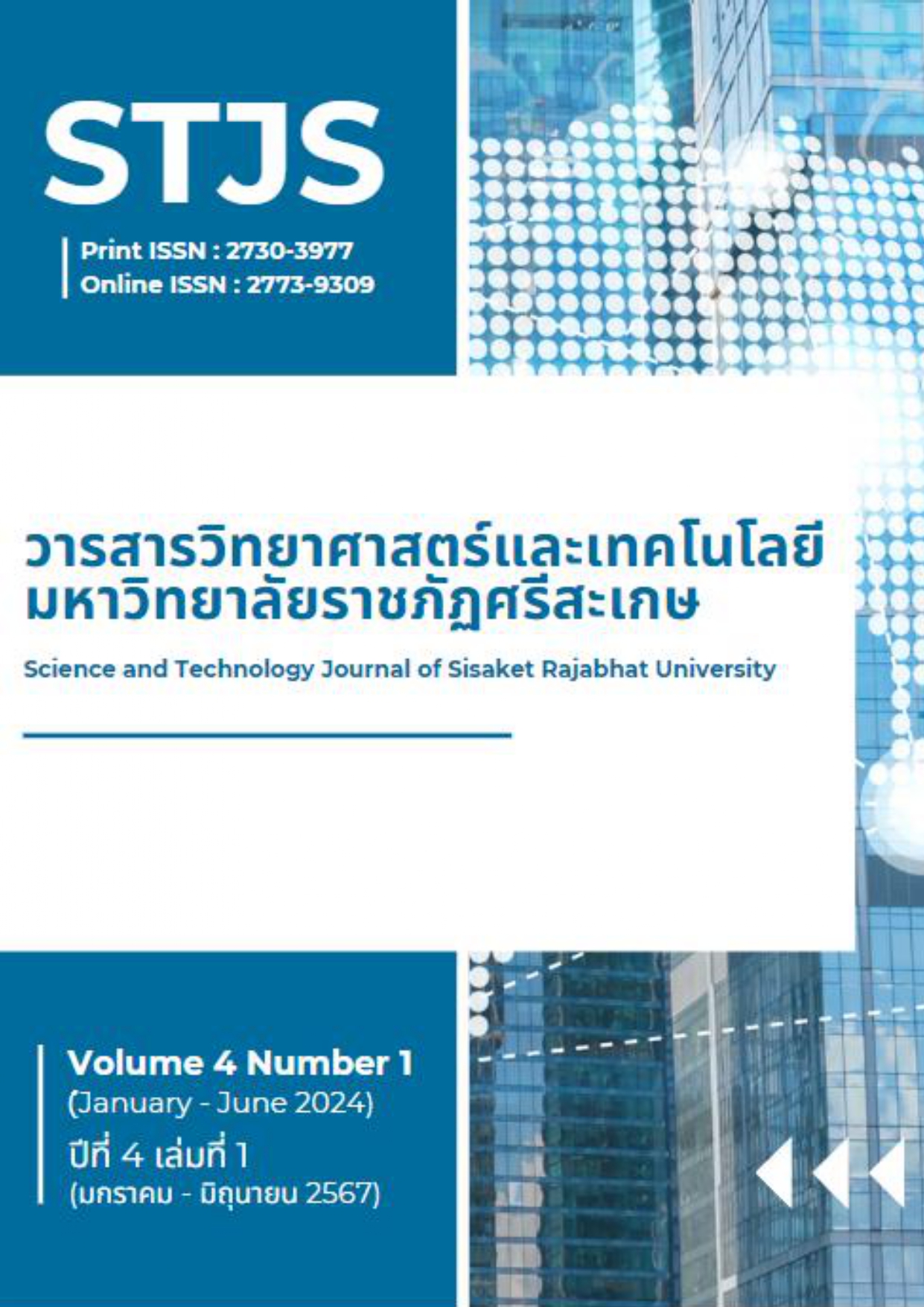การศึกษาผลของแหนแดงต่อการเจริญเติบโตและผลผลิต ของข้าวเหนียวดำในพื้นที่ป่าเปิดใหม่
Main Article Content
บทคัดย่อ
Article Details

อนุญาตภายใต้เงื่อนไข Creative Commons Attribution-NonCommercial-NoDerivatives 4.0 International License.
เนื้อหาและข้อมูลในบทความที่ลงตีพิมพ์ในวารสารวิทยาศาสตร์และเทคโนโลยี มหาวิทยาลัยราชภัฏศรีสะเกษ ถือเป็นข้อคิดเห็นและความรับผิดชอบของผู้เขียนบทความโดยตรงซึ่งกองบรรณาธิการวารสาร ไม่จำเป็นต้องเห็นด้วย หรือร่วมรับผิดชอบใด ๆ
บทความ ข้อมูล เนื้อหา รูปภาพ ฯลฯ ที่ได้รับการตีพิมพ์ในวารสารวิทยาศาสตร์และเทคโนโลยี มหาวิทยาลัยราชภัฏศรีสะเกษ ถือเป็นลิขสิทธิ์ของวิทยาศาสตร์และเทคโนโลยี มหาวิทยาลัยราชภัฏศรีสะเกษ หากบุคคลหรือหน่วยงานใดต้องการนำทั้งหมดหรือส่วนหนึ่งส่วนใดไปเผยแพร่ต่อหรือเพื่อกระทำการใด จะต้องได้รับอนุญาตเป็นลายลักอักษรจากวารสารวิทยาศาสตร์และเทคโนโลยี มหาวิทยาลัยราชภัฏศรีสะเกษ ก่อนเท่านั้น
เอกสารอ้างอิง
Chen, XY., Zhou, J., Luo, LP., et al. (2015). Black rice anthocyanins suppress metastasis of breast cancer cells by targeting RAS/RAF/MAPK pathway. BioMed Research International, 2015, 1-11.
Cheng, SC. and Jackson, ML. (1957). Fractionation of Soil Phosphorus. Soil Sci. 84: 133-144.
Dranfield, JD. (1979). A manual of the rattans of the Malay Peninsula. Malaysia: Forest Department, Ministry of Primary Industries.
Dumnin, K. and Sansanee, J. (2000). Complete research report on genetics, breeding and agricultural nutrition of black glutinous rice. Chiang Mai: Institute of Science and Technology Research and Development, Chiang Mai University. (in Thai)
Khumnok, B. (1994). Influence of pH on the uptake of phosphate radicals in soils at high altitudes. Master's thesis. Chiang Mai University. (in Thai)
Li, SY. (1984). Azolla in the paddy fields of Eastern China. Manila: Organic Matter and Rice.
Lumpkin, TA. and Plucknett, DL. (1982). Azolla as a Green Manure: Use and Management in Crop Production. Colorado: Westview Press.
Milicia, F. (1992). Azolla symbiotic system’s application as biofertilizer for green garden crops. Symbiosis, 14, 495 -500.
Siriluk, K. and Prapai, T. (2010). Study of the decomposition and release of nitrogen of Azolla in various soil conditions. Bangkok: B B Copy & Print. (in Thai)
Siriluk, K., Prapai, T., Kanda, C. and Pasat, S. (2018). Effects of Azolla on the growth of Chinese kale. 17th National Horticultural Conference, November 19-21, 2018. Chiang Mai: Chiang Mai Grandview Hotel and Convention Center. (in Thai)
Surangrat, P. and Pongpaka, K. (2020). Study of the amount of organic matter in the soil and riceberry yield using fresh Azolla and bio-organic fertilizer from Azolla. Kaen Kaset, 48(1), 1211-1226. (in Thai)
Wichen, P. (1995). Techniques and use of soil-fertilizer-water. Surin: Faculty of Science and Technology, Surin Rajabhat University. (in Thai)
Pranaso, S. (2010). Agricultural production factors. Bangkok: Department of Agriculture. (in Thai)
Prayon. S. (1994). Utilization of Azolla as a biological fertilizer. Bangkok: Department of Agriculture. (in Thai)
Singh, P. (1992). Biofertilizers for flooded rice ecosystem fertilizers organic manures, Recyclable Wastes and Biofertilizers. New Delhi: India.
Subedi, P. and Shrestha, J. (2015). Improving soil fertility through Azolla application in low land rice: A review. Azar. J. Agri, 2(2), 35-39.
Hui, C., Bin, Y., Xiaoping, Y., Long, Y., Chunye, C., Mantian, M., and Wenhua, L. (2010). Anticancer activities of an anthocyanin-rich extract from black rice against breast cancer cells in vitro and in vivo. Nutrition and Cancer, 62(8), 1128-1136.
Watanabe, I., Ito, O., and Espinas, CR. (1981). Growth of azolla with rice and its effect on rice yield. International Rice Research Newsletter, 6(1), 22-23.
Walkley, A. and Black I.A., (1934). An examination of the Degtjareff Method for Determining Soil Organic Matter, and a proposed Modification of the Chromic Acid Titration Method. Soil Science, 6(6), 29-38.
Xu, JM., Tang, C., and Chen, ZL. (2006). Chemical composition controls residue decomposition in soils differing in initial pH. Soil Biology & Biochemistry. 38, 544-552.


